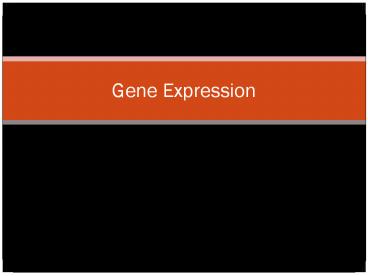Gene Expression - PowerPoint PPT Presentation
Title:
Gene Expression
Description:
Gene Expression Remember, every cell in your body contains the exact same DNA so why does a muscle cell have different structure and function than a nerve cell? – PowerPoint PPT presentation
Number of Views:349
Avg rating:3.0/5.0
Title: Gene Expression
1
Gene Expression
2
so why does a muscle cell have different
structure and function than a nerve cell?
- Remember, every cell in your body contains the
exact same DNA
3
Review DNA codes for
Proteins!
4
Proteins being produced can be turned off and on
just like a light switch based on the needs of a
cell.
5
Chromosomes
- A structurally organized single piece of coiled
DNA containing many different genes. Each gene
will code for ONE single PROTEIN.
Gene 1
Gene 2
Gene 3
Gene 4
Gene 5
Gene 6
6
Regulated Gene Expression
- Regulated control the speed/amount
- Gene Expression using the information from a
gene to express a protein - Regulated Gene Expression how a cell controls
the speed or amount of a gene being expressed as
a protein
7
Methods of regulation
- In Eukaryotes
- Regulating transcription (DNA ? mRNA) by
- Activator Proteins
- Promoters
- 2. Splicing of mRNA
- Exons - Expressed
- In Prokaryotes
- Regulating transcription (DNA ? mRNA) by
- Operators
- Promoters
- Repressor Protein
8
Regulation in Eukaryotes1 Regulating
Transcription (DNA ? mRNA)
- If a protein is needed by the cell, a gene coding
for that protein needs to be expressed,
TRANSCRIPTION WILL OCCUR. - If a protein is NOT needed by the cell,
TRANSCRIPTION WILL STOP.
9
Eukaryotic Transcription Factors
- - Activator Protein - a molecule that turns ON
transcription - - Transcription Factors molecules that allow
RNA Polymerase to bind to DNA and begin
transcription - - Promoter sequence
- on DNA before the
- Gene where Activator
- Proteins and
- Transcription
- Factors can bind to
10
EukaryoticTranscription will TURN ON
- When Activators and Transcription Factors are
both bound to the Promoter site, RNA polymerase
will bind to DNA and begin transcription. - The gene will be transcribed and the protein will
be translated/expressed.
11
Eukaryotic Splicing RNA
- After Transcription Portions of the transcribed
mRNA is (spliced) cut out - Exons the portions of the gene on mRNA that are
cut, translated, and EXPRESS proteins - Intron the portions of the gene on mRNA that do
not code for proteins and are NOT expressed - The spliced Exons will then code for a Protein!
12
Regulation of Prokaryotic Genes
- Operon multiple genes that are grouped together
on one consecutive segment of DNA that is
transcribed/copied onto ONE single mRNA - Promoter sequence in an operon where RNA
polymerase binds to and begins transcription - Operator sequence in an operon where a
repressor can bind or unbind to - Repressor a protein that can bind to the
operator to PREVENT Transcription from occurring
13
Lac Operon - Prokaryotes
- Lac Operon a DNA sequence of three genes (Lac Z,
Lac Y, Lac A) that codes for proteins that
break down lactose
14
When lactose is present
- Repressor is NOT BOUND to the operator - RNA
polymerase can bind to the PROMOTER and
TRANSCRIPTION OCCURS - Expression of lactase
proteins occurs
15
When lactose is absent
Repressor IS BOUND to the operator RNA
polymerase can NOT bind to the PROMOTER and
TRANSCRIPTION Does NOT Occur Expression of
lactase proteins is REPRESSED! (switch is OFF)































